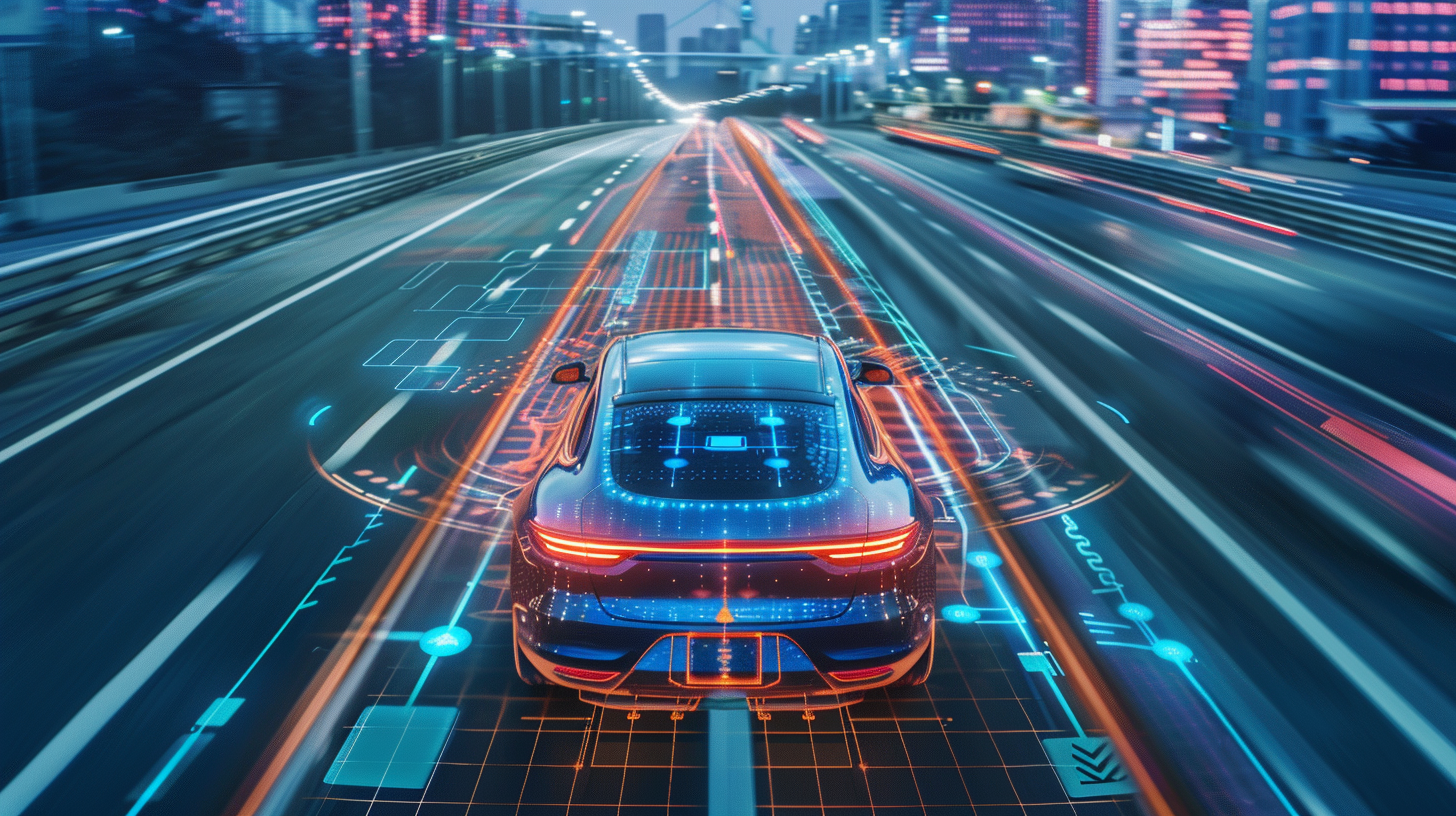Table of Contents Show
Like a car cruising down an open highway, we’re rapidly approaching an exciting era in the world of transportation technology, where electric cars and autonomous driving are poised to redefine our roads. We’ve witnessed the evolution of electric vehicles from niche to mainstream, and autonomous driving technology is accelerating at an impressive pace. But as we navigate this shift, there are significant hurdles to overcome, from environmental impacts and safety challenges to infrastructural needs and public acceptance. With so much at stake and the landscape continually evolving, it’s essential to explore what the future holds for these innovations and their potential to revolutionize how we move. So, let’s shift gears and consider the road ahead, where the rubber meets the road in transportation technology.
Key Takeaways
- EVs and autonomous vehicles are transforming transportation with sustainability and high performance.
- Expanding charging and autonomous infrastructure is key to global EV adoption.
- Legislative support and innovation in safety protocols are critical for advancement.
- Technological advancements in EVs and autonomous driving reduce emissions and improve safety.
The Evolution of Electric Vehicles
The journey of electric vehicles (EVs) from obscure experiments to mainstream transportation solutions has revolutionized how we view and use cars. We’ve seen them evolve from the early days of limited range and scarce charging stations to the high-performance, sleek machines that now grace our roads. This transformation embodies our collective desire for freedom—freedom from the clutches of fossil fuels, from the pollution choking our cities, and from the endless cycle of oil dependency.
We’re embracing EVs not just because they’re environmentally friendly, but because they offer a new form of liberation on the road. With the push towards renewable energy, we’re also seeing a shift towards a more sustainable and self-sufficient lifestyle. Driving an electric car means we’re part of a movement that’s reshaping the landscape of transportation, making it cleaner, greener, and more aligned with our values of conservation and responsibility towards the planet.
This evolution isn’t just about changing what powers our cars; it’s about reimagining our relationship with transportation. We’re moving towards a future where our vehicles are not just tools for getting from A to B, but symbols of our commitment to innovation and environmental stewardship. The rise of electric vehicles is a proof of our ingenuity and determination to forge a better path forward. It’s a journey we’re on together, driving towards a future where freedom and sustainability go hand in hand.
Breaking Down Autonomous Driving
As we shift our focus to autonomous driving, it’s important to understand its complexities and classifications. We’ll explore the varying levels of autonomy that define how these vehicles operate, and the safety and regulations that shape their integration into our daily lives. This discussion lays the groundwork for appreciating the technological advancements and challenges in autonomous vehicle development.
Levels of Autonomy
Understanding autonomous driving requires breaking down its levels, from basic driver assistance to full automation. It’s about giving you the freedom to choose how you engage with your vehicle.
Here’s what you need to know:
- Level 0: No automation. You’re in full control, steering the course of your journey.
- Level 1 & 2: Here, we’re talking about driver assistance and partial automation. These levels offer a taste of freedom, allowing the car to handle tasks like braking or steering under certain conditions.
- Level 3 to 5: These levels represent conditional to full automation. Imagine sitting back and enjoying the ride as your car navigates the complexities of the road on its own.
Embrace the freedom that comes with understanding autonomy levels and how they can revolutionize your driving experience.
Safety and Regulations
Exploring the world of autonomous driving also means addressing the essential aspects of safety and regulations that govern these technologies. We’re entering a future where our streets are safer and our journeys more efficient, all thanks to the advancements in autonomous vehicles. But with great power comes great responsibility. It’s critical that we have robust safety protocols and regulations in place to guarantee these vehicles don’t just promise freedom, but also protect it.
We’re advocating for clear, flexible regulations that adapt to the rapid pace of technological innovation. These rules shouldn’t stifle creativity; they should foster an environment where safety and freedom go hand in hand. Let’s push for regulations that prioritize public safety while also letting innovation thrive, ensuring that the road ahead is safe for everyone.
Environmental Impact and Benefits
We’re now turning our attention to the environmental impact and benefits of electric cars and autonomous driving. It’s clear that these technologies hold the promise of reducing carbon emissions and enhancing air quality. Let’s explore how they’re set to revolutionize our approach to sustainability in transportation.
Reducing Carbon Emissions
Electric cars and autonomous driving technologies offer a substantial opportunity to slash carbon emissions, directly benefiting the environment. By embracing these innovations, we’re not just investing in cleaner air; we’re paving the way for a future where freedom and sustainability go hand in hand. Here’s how we can make a difference:
- Switching to Electric Vehicles (EVs): By choosing EVs over traditional gas-powered cars, we reduce the demand for fossil fuels, cutting down on greenhouse gas production.
- Optimizing Routes: Autonomous vehicles can calculate the most efficient routes, minimizing unnecessary mileage and, consequently, emissions.
- Encouraging Car Sharing: With autonomous technology, sharing rides becomes more accessible and appealing, substantially reducing the number of vehicles on the road and their emissions.
Let’s grab this chance to drive our world toward a cleaner, greener future.
Enhancing Air Quality
By adopting electric and autonomous driving technologies, we’re directly contributing to significant enhancements in air quality, with immediate and long-term environmental benefits. These innovations are paving the way for us to breathe easier, quite literally. By cutting down on the pollutants that traditional vehicles emit, we’re not just making a statement about our commitment to the planet; we’re also taking concrete steps towards ensuring healthier lives for ourselves and future generations. This shift towards cleaner transportation options means we’re embracing the freedom to move around in ways that don’t compromise the air we all share. Let’s continue to drive forward, knowing that every electric mile traveled is a breath of fresh for our communities and our world.
Safety Innovations and Challenges
The advent of autonomous driving technology brings both groundbreaking safety innovations and significant challenges to the forefront of transportation tech. As we embrace these advancements, we’re not just passengers on a journey; we’re pioneers in a movement toward freedom and safety on our roads.
-
Advanced Driver-Assistance Systems (ADAS): Modern electric and autonomous vehicles are equipped with ADAS, including features like automatic braking, lane-keeping assist, and adaptive cruise control. These systems don’t just make driving easier; they make it safer, reducing the likelihood of human error, which is the leading cause of accidents on the road.
-
Data Privacy and Security: With great technology comes great responsibility. As our cars become more connected, we face the challenge of protecting the vast amounts of data they generate. Ensuring the privacy and security of this data is paramount. It’s a challenge we must conquer to maintain the trust and freedom of those who choose to embrace autonomous driving.
-
Ethical Decision Making: Autonomous vehicles promise to reduce accidents caused by human error, but they also pose ethical questions. How should a vehicle react in an unavoidable accident scenario? This challenge requires not just technological solutions, but a societal consensus on the values we want our autonomous vehicles to prioritize.
As we navigate these challenges, we’re not just looking for solutions; we’re shaping the future of mobility. Our commitment to safety innovations guarantees that as we move toward a future of autonomous driving, we’re not just seeking freedom for ourselves, but for everyone on the road.
Infrastructure and Charging Solutions
As we explore the domain of electric cars and autonomous driving, it’s essential we also address the backbone of this revolution: infrastructure and charging solutions. We’re seeing an impressive global push to expand the charging network, alongside significant strides in fast charging technology. Additionally, the prospects of wireless charging are setting the stage for a truly transformative phase in how we power our vehicles.
Global Charging Network Expansion
We’re witnessing a monumental expansion in the global charging network to accommodate the growing fleet of electric vehicles. This growth is not just about quantity but also about spreading freedom on the road for EV owners. Here’s how:
- Vital Accessibility: More charging stations mean you’re never too far from a power-up, making long trips worry-free.
- Varied Locations: Chargers are popping up in urban and rural areas, ensuring you’re covered wherever your adventures take you.
- Integration with Renewable Energy: Many new stations are leveraging solar and wind power, helping you drive cleaner and greener.
This expansion is vital for ensuring that electric vehicle owners feel the freedom of the road without limitations, truly revolutionizing how we approach travel and sustainability.
Fast Charging Technology Advances
Building on the global charging network expansion, fast charging technology advances are redefining the refueling experience for electric vehicles. We’re witnessing a thrilling era where waiting hours for a charge is becoming a thing of the past. Now, we can power up our rides in the time it takes to grab a coffee, bringing us closer to the freedom of the road that we’ve always cherished. These breakthroughs not only slash charging times but also push boundaries, making long trips more feasible and electric vehicles more appealing. As we embrace these innovations, we’re not just adopting new technology; we’re paving the way for a future where our journeys are limited only by our imagination, not our vehicle’s battery level.
Wireless Charging: Future Prospects
How will wireless charging revolutionize the landscape of electric vehicle infrastructure and charging solutions? We’re standing on the brink of a significant shift, where the hassle of plugging in could become a thing of the past. Imagine the freedom of simply parking your car and having it charge automatically. Here’s how we’ll benefit:
- Seamless Integration: Parking spots equipped with wireless charging pads mean we can juice up without a second thought.
- Reduced Clutter: Without the need for cables, our streets and parking lots will look cleaner and more organized.
- Greater Accessibility: Making charging stations more user-friendly encourages the switch to electric, offering a greener future for everyone.
Wireless charging isn’t just a convenience; it’s a leap towards the freedom of movement without the traditional bounds of energy replenishment.
Legislative Landscape and Policies
Exploring the legislative landscape, governments worldwide are actively shaping policies to regulate electric cars and autonomous driving technologies. We’re witnessing a significant shift as legislators grapple with the need to foster innovation while ensuring public safety and environmental sustainability. It’s a vital balance, but one that’s essential for our freedom to navigate the future of transportation.
As we dive deeper, it’s clear that incentives for electric vehicle (EV) adoption are becoming more common. Tax breaks, grants, and subsidies are tools governments are using to make electric cars more accessible to the masses. We’re also seeing investments in infrastructure, like charging stations, which are essential for the widespread adoption of EVs. These policies aren’t just about promoting cleaner vehicles; they’re about giving us the freedom to choose a sustainable mode of transportation without compromising on convenience.
On the autonomous driving front, the regulatory environment is evolving. We’re part of a global conversation on safety standards and liability issues, which are paramount for the integration of self-driving cars into our daily lives. Regulations are being crafted to protect us while keeping the road open for technological advancements.
It’s a thrilling time to be part of this transformation. As these policies take shape, they’re not just guiding the development of technology; they’re paving the way for us to enjoy greater freedom, safety, and environmental responsibility. We’re at the forefront of a revolution, and the policies being made today will determine how freely we can move tomorrow.
Public Perception and Adoption
Shifting public perception and increasing adoption are critical for the success of electric cars and autonomous driving technologies. We’ve observed a gradual change in how society views these innovations, moving from skepticism to curiosity and, in many cases, enthusiasm. This shift is pivotal, as it directly influences market growth and the pace at which these technologies become integral parts of our daily lives.
To really enjoy the journey toward widespread adoption, let’s look at three key areas:
-
Environmental Impact: We’re all seeking ways to reduce our carbon footprint and embrace a more sustainable lifestyle. Electric vehicles (EVs) offer us the chance to do just that, turning our desire for freedom into a force for good. Their lower emissions support cleaner air and a healthier planet, aligning with our values and aspirations.
-
Cost Savings: Initially, the cost of EVs and autonomous vehicles might seem high, but we must consider the long-term savings. Reduced fuel consumption and lower maintenance costs free us from the constant drain of traditional vehicle expenses, making financial freedom more attainable.
-
Innovative Features: The allure of cutting-edge technology is undeniable. Autonomous driving and electric vehicles come packed with features that promise not just ease of use but a revolutionary driving experience. From self-parking to advanced navigation systems, these technologies offer us a glimpse into a future where our vehicles are not just tools, but partners in our journey.
We’re on the brink of a major transformation in how we view and use transportation. By embracing these changes, we’re not just adopting new technologies; we’re stepping into a future where our movement is cleaner, smarter, and more aligned with our quest for freedom and sustainability.
Future Technologies on the Horizon
Building on our journey toward sustainable and intelligent transportation, let’s now examine the emerging technologies set to redefine our travel experiences. We’re on the brink of a revolution, where the freedom to roam is not just about moving from point A to B, but doing so in ways we’ve only dreamed of.
We’re talking about vehicles powered by cutting-edge energy solutions that promise longer ranges and lightning-fast charging times, making "range anxiety" a thing of the past. Imagine setting off on an adventure without worrying about where the next charging station is. That’s the future we’re headed toward.
Then, there’s the advancement in autonomous driving technology. We’re not just looking at cars that can navigate highways autonomously; we’re envisioning vehicles that can handle complex urban environments with the same ease as a seasoned driver. This leap forward isn’t just about convenience; it’s about granting us the freedom to use our travel time as we see fit—be it working, reading, or just relaxing.
Let’s not forget the integration of artificial intelligence into our vehicles. AI is set to transform our rides into personalized journeys, learning our preferences, optimizing our routes in real-time, and ensuring that our trips are not just safe, but also enjoyable.
As we look ahead, it’s clear that the road to the future is paved with technologies that promise to make our lives easier, our planet greener, and our spirits freer. We’re not just passengers on this journey; we’re co-pilots, steering toward a horizon brimming with possibilities.
Economic Implications and Opportunities
As we explore the economic implications and opportunities presented by electric cars and autonomous driving, it’s crucial to comprehend the transformative impact these technologies will have on markets and job landscapes. These innovations aren’t just about cleaner air or reducing traffic jams; they’re poised to revolutionize the way we think about employment, investment, and entrepreneurship in the transportation sector.
Here are three key points to ponder:
-
Job Creation and Shift: While automation may phase out traditional driving jobs, it’ll simultaneously ignite demand for new skill sets. We’re talking about engineers, software developers, and maintenance specialists for these high-tech vehicles. It’s a shift, not a disappearance, of opportunities in the labor market.
-
Investment Surge: Electric and autonomous vehicles are magnets for investment. From startups developing cutting-edge tech to established companies pivoting towards green energy, the financial landscape is ripe for those willing to dive into this sector. It’s a chance for investors to back ventures that not only promise returns but also drive societal progress.
-
Entrepreneurial Boom: This revolution opens the door for entrepreneurs. With the rise of electric and autonomous vehicles, new services and business models are emerging. Think along the lines of charging station networks, autonomous ride-sharing services, and more. It’s a playground for innovation, offering freedom to those who dare to redefine mobility.
As we embrace these changes, it’s clear that electric cars and autonomous driving aren’t just altering how we move; they’re reshaping the economic horizon with abundant opportunities for those ready to seize them.
Global Trends and Market Predictions
We’re witnessing an unprecedented surge in the global adoption of electric and autonomous vehicles, reshaping market dynamics and propelling new investment opportunities. This shift isn’t just about cleaner, more efficient cars; it’s a revolution that promises to free us from the constraints of traditional transportation. The roads of tomorrow won’t be congested with gas-guzzlers and the air will be cleaner, giving us the freedom to breathe easier and live healthier.
As we look ahead, we’re seeing clear trends that suggest electric vehicles (EVs) and autonomous driving technologies are not just fleeting fads but are on track to dominate the market. Analysts predict that by 2030, EVs could represent up to 50% of new car sales globally, a figure that seemed unimaginable just a decade ago. This shift is being fueled by advances in battery technology, which are making EVs more affordable and convenient for the average consumer.
Meanwhile, autonomous driving tech is advancing at a breakneck pace, promising a future where we’re free from the drudgery of daily commutes and the dangers of human error on the roads. This isn’t just speculation; major tech and automotive companies are investing billions into making this vision a reality, with pilot projects already showing promising results.
Conclusion
As we cruise down the electrified highway of innovation, it’s clear that electric and autonomous vehicles are steering us toward a greener, smarter future. The road ahead is paved with opportunities to slash emissions, enhance safety, and revolutionize how we move. We’re at the dawn of a transportation renaissance, where every mile driven is a step closer to a sustainable, interconnected world. Together, let’s shift gears and accelerate into a future where technology drives us forward, leaving a cleaner, safer planet in our rearview mirror.








